Applied Corporate Strategy Report: Sainsbury's Performance
VerifiedAdded on 2020/10/22
|20
|5490
|274
Report
AI Summary
This report provides a detailed analysis of Sainsbury's corporate strategy, examining both its internal and external environments. The introduction defines the business environment and corporate strategy, setting the stage for an in-depth exploration of Sainsbury's operations. The main body of the report begins with an external analysis, employing tools like PESTLE and Porter's Five Forces to identify opportunities and threats within the market. This is followed by an internal analysis, assessing Sainsbury's resources, key competencies, strengths, and weaknesses. The report also evaluates Sainsbury's strategic capabilities using the VRIO framework. The report concludes with a summary of findings and implications for Sainsbury's future strategies, referencing key insights from the analysis. The report covers aspects like market dynamics, competitive positioning, and strategic decision-making within the retail sector.
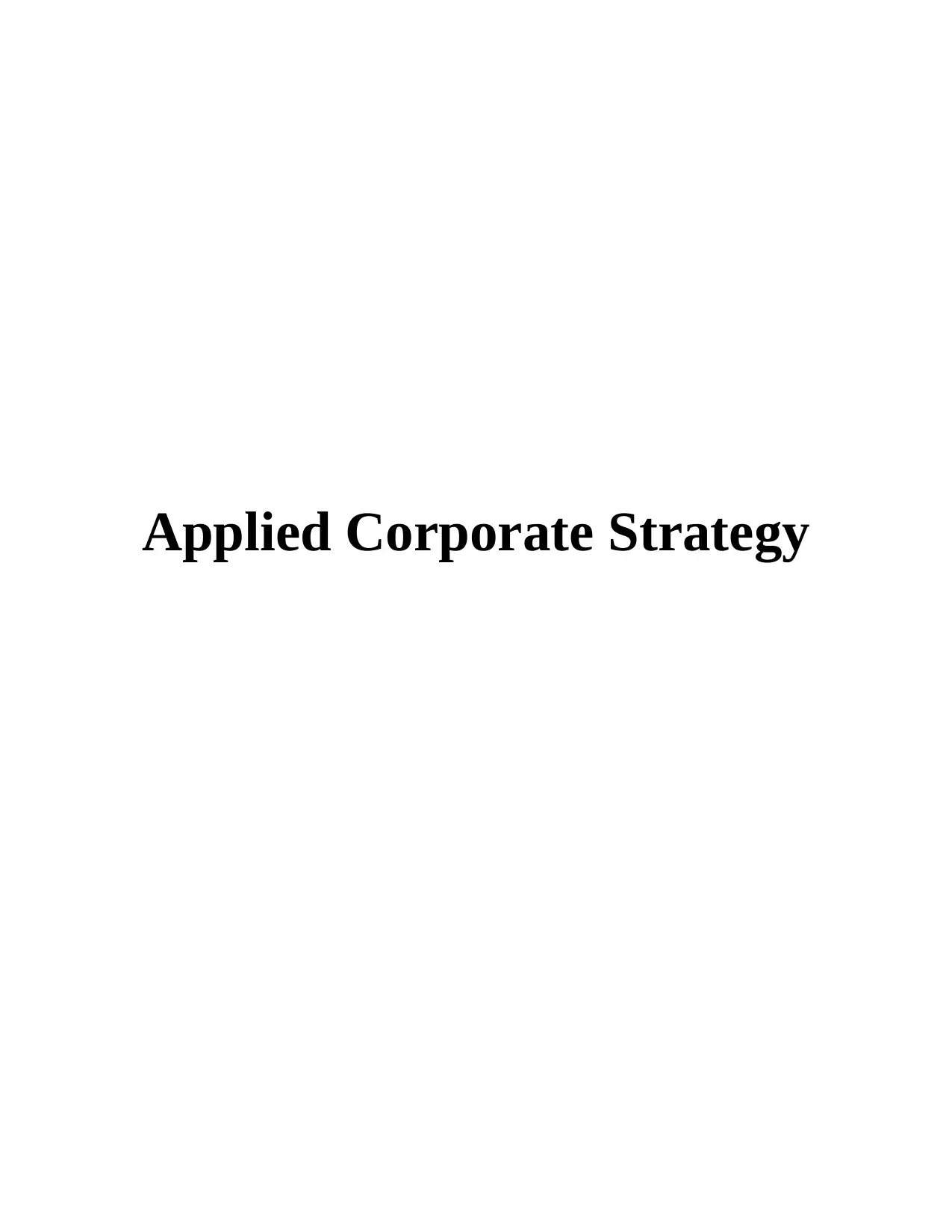
Applied Corporate Strategy
Paraphrase This Document
Need a fresh take? Get an instant paraphrase of this document with our AI Paraphraser
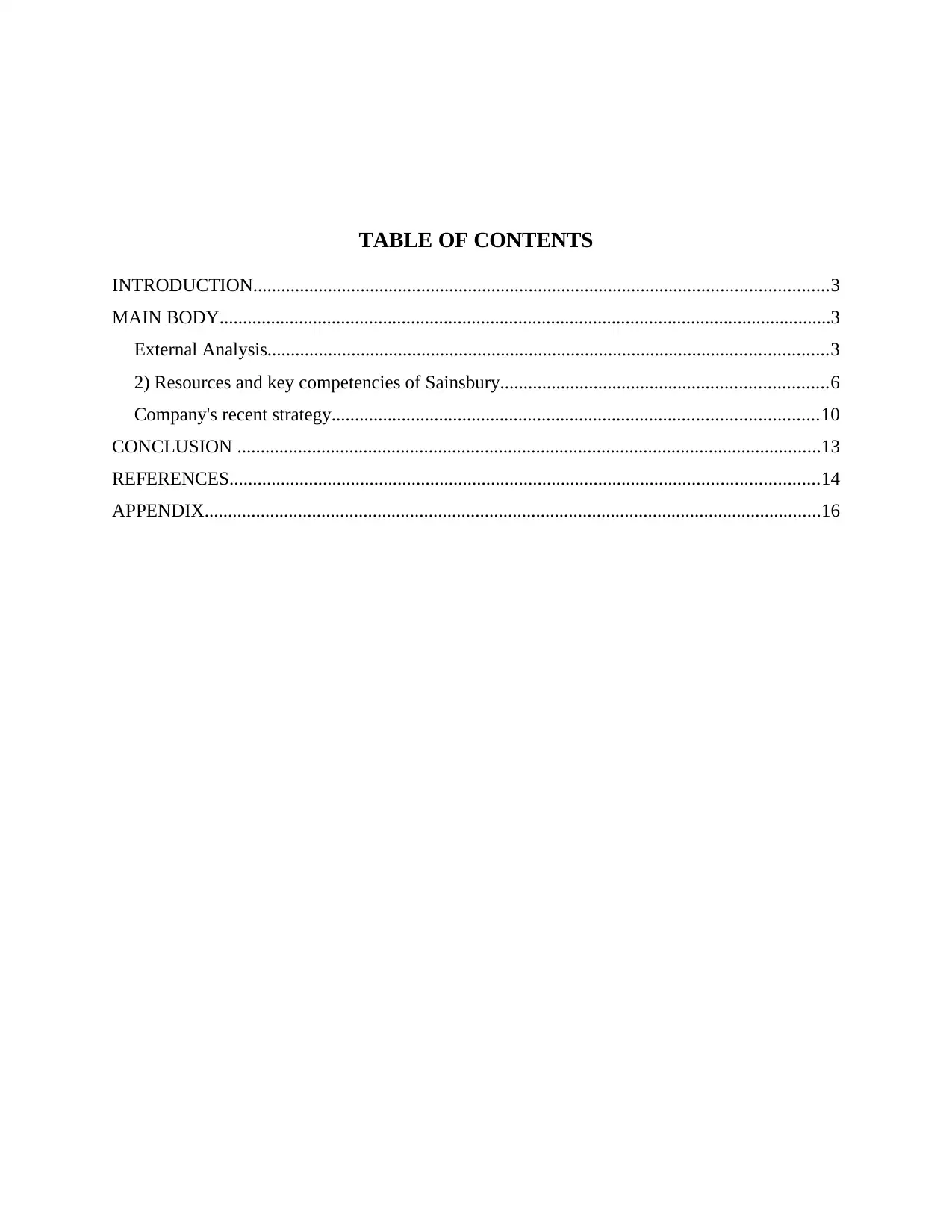
TABLE OF CONTENTS
INTRODUCTION...........................................................................................................................3
MAIN BODY...................................................................................................................................3
External Analysis........................................................................................................................3
2) Resources and key competencies of Sainsbury......................................................................6
Company's recent strategy........................................................................................................10
CONCLUSION .............................................................................................................................13
REFERENCES..............................................................................................................................14
APPENDIX....................................................................................................................................16
INTRODUCTION...........................................................................................................................3
MAIN BODY...................................................................................................................................3
External Analysis........................................................................................................................3
2) Resources and key competencies of Sainsbury......................................................................6
Company's recent strategy........................................................................................................10
CONCLUSION .............................................................................................................................13
REFERENCES..............................................................................................................................14
APPENDIX....................................................................................................................................16
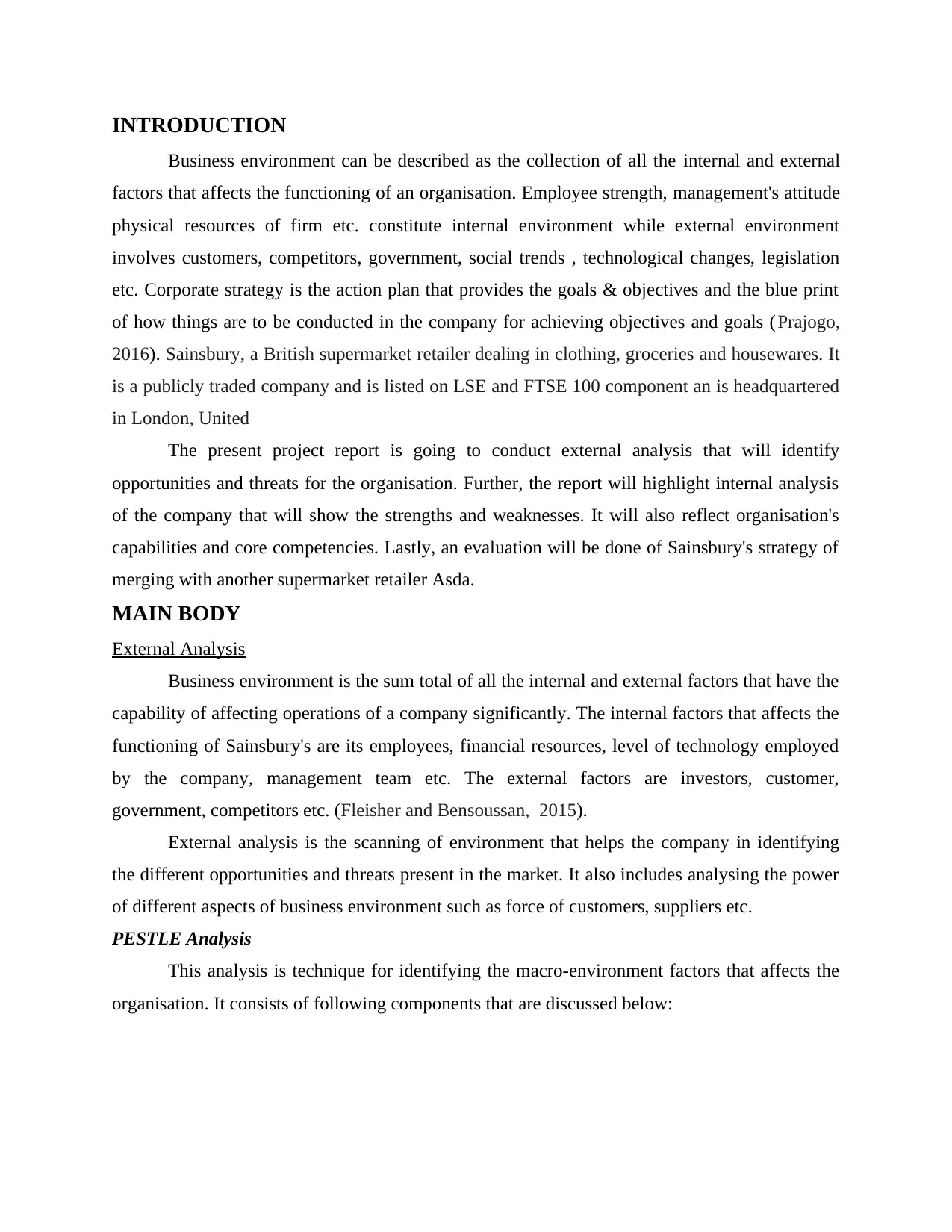
INTRODUCTION
Business environment can be described as the collection of all the internal and external
factors that affects the functioning of an organisation. Employee strength, management's attitude
physical resources of firm etc. constitute internal environment while external environment
involves customers, competitors, government, social trends , technological changes, legislation
etc. Corporate strategy is the action plan that provides the goals & objectives and the blue print
of how things are to be conducted in the company for achieving objectives and goals (Prajogo,
2016). Sainsbury, a British supermarket retailer dealing in clothing, groceries and housewares. It
is a publicly traded company and is listed on LSE and FTSE 100 component an is headquartered
in London, United
The present project report is going to conduct external analysis that will identify
opportunities and threats for the organisation. Further, the report will highlight internal analysis
of the company that will show the strengths and weaknesses. It will also reflect organisation's
capabilities and core competencies. Lastly, an evaluation will be done of Sainsbury's strategy of
merging with another supermarket retailer Asda.
MAIN BODY
External Analysis
Business environment is the sum total of all the internal and external factors that have the
capability of affecting operations of a company significantly. The internal factors that affects the
functioning of Sainsbury's are its employees, financial resources, level of technology employed
by the company, management team etc. The external factors are investors, customer,
government, competitors etc. (Fleisher and Bensoussan, 2015).
External analysis is the scanning of environment that helps the company in identifying
the different opportunities and threats present in the market. It also includes analysing the power
of different aspects of business environment such as force of customers, suppliers etc.
PESTLE Analysis
This analysis is technique for identifying the macro-environment factors that affects the
organisation. It consists of following components that are discussed below:
Business environment can be described as the collection of all the internal and external
factors that affects the functioning of an organisation. Employee strength, management's attitude
physical resources of firm etc. constitute internal environment while external environment
involves customers, competitors, government, social trends , technological changes, legislation
etc. Corporate strategy is the action plan that provides the goals & objectives and the blue print
of how things are to be conducted in the company for achieving objectives and goals (Prajogo,
2016). Sainsbury, a British supermarket retailer dealing in clothing, groceries and housewares. It
is a publicly traded company and is listed on LSE and FTSE 100 component an is headquartered
in London, United
The present project report is going to conduct external analysis that will identify
opportunities and threats for the organisation. Further, the report will highlight internal analysis
of the company that will show the strengths and weaknesses. It will also reflect organisation's
capabilities and core competencies. Lastly, an evaluation will be done of Sainsbury's strategy of
merging with another supermarket retailer Asda.
MAIN BODY
External Analysis
Business environment is the sum total of all the internal and external factors that have the
capability of affecting operations of a company significantly. The internal factors that affects the
functioning of Sainsbury's are its employees, financial resources, level of technology employed
by the company, management team etc. The external factors are investors, customer,
government, competitors etc. (Fleisher and Bensoussan, 2015).
External analysis is the scanning of environment that helps the company in identifying
the different opportunities and threats present in the market. It also includes analysing the power
of different aspects of business environment such as force of customers, suppliers etc.
PESTLE Analysis
This analysis is technique for identifying the macro-environment factors that affects the
organisation. It consists of following components that are discussed below:
⊘ This is a preview!⊘
Do you want full access?
Subscribe today to unlock all pages.

Trusted by 1+ million students worldwide
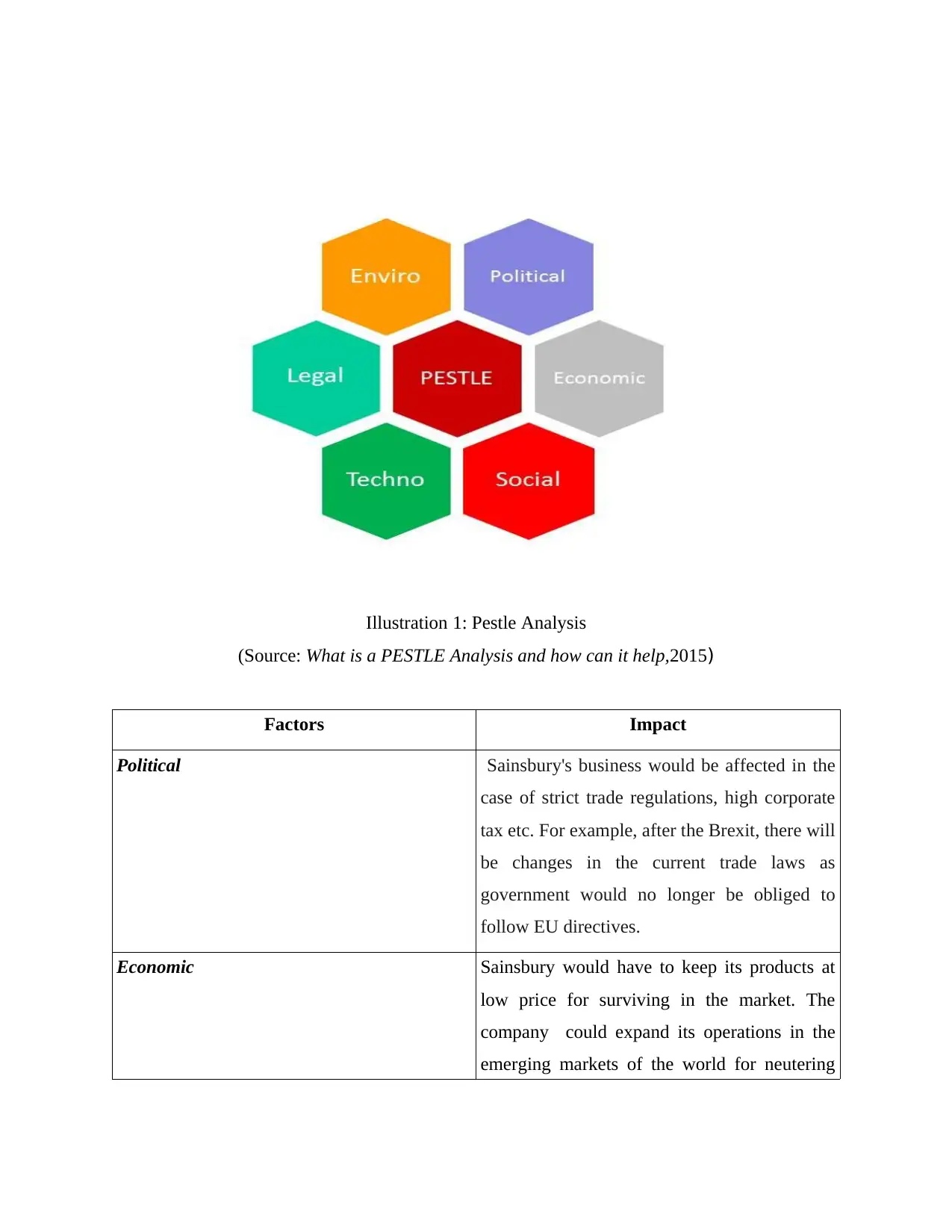
Illustration 1: Pestle Analysis
(Source: What is a PESTLE Analysis and how can it help,2015)
Factors Impact
Political Sainsbury's business would be affected in the
case of strict trade regulations, high corporate
tax etc. For example, after the Brexit, there will
be changes in the current trade laws as
government would no longer be obliged to
follow EU directives.
Economic Sainsbury would have to keep its products at
low price for surviving in the market. The
company could expand its operations in the
emerging markets of the world for neutering
(Source: What is a PESTLE Analysis and how can it help,2015)
Factors Impact
Political Sainsbury's business would be affected in the
case of strict trade regulations, high corporate
tax etc. For example, after the Brexit, there will
be changes in the current trade laws as
government would no longer be obliged to
follow EU directives.
Economic Sainsbury would have to keep its products at
low price for surviving in the market. The
company could expand its operations in the
emerging markets of the world for neutering
Paraphrase This Document
Need a fresh take? Get an instant paraphrase of this document with our AI Paraphraser
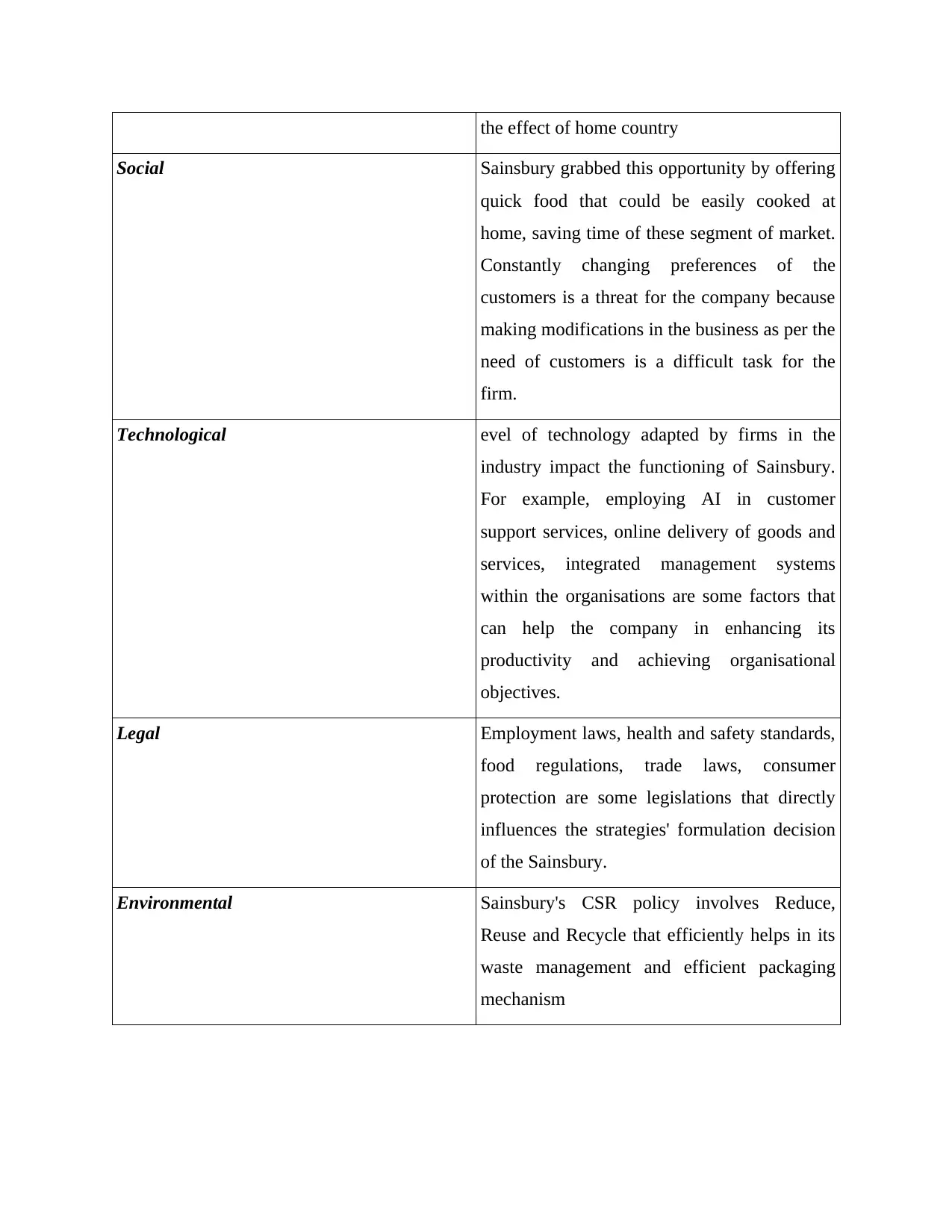
the effect of home country
Social Sainsbury grabbed this opportunity by offering
quick food that could be easily cooked at
home, saving time of these segment of market.
Constantly changing preferences of the
customers is a threat for the company because
making modifications in the business as per the
need of customers is a difficult task for the
firm.
Technological evel of technology adapted by firms in the
industry impact the functioning of Sainsbury.
For example, employing AI in customer
support services, online delivery of goods and
services, integrated management systems
within the organisations are some factors that
can help the company in enhancing its
productivity and achieving organisational
objectives.
Legal Employment laws, health and safety standards,
food regulations, trade laws, consumer
protection are some legislations that directly
influences the strategies' formulation decision
of the Sainsbury.
Environmental Sainsbury's CSR policy involves Reduce,
Reuse and Recycle that efficiently helps in its
waste management and efficient packaging
mechanism
Social Sainsbury grabbed this opportunity by offering
quick food that could be easily cooked at
home, saving time of these segment of market.
Constantly changing preferences of the
customers is a threat for the company because
making modifications in the business as per the
need of customers is a difficult task for the
firm.
Technological evel of technology adapted by firms in the
industry impact the functioning of Sainsbury.
For example, employing AI in customer
support services, online delivery of goods and
services, integrated management systems
within the organisations are some factors that
can help the company in enhancing its
productivity and achieving organisational
objectives.
Legal Employment laws, health and safety standards,
food regulations, trade laws, consumer
protection are some legislations that directly
influences the strategies' formulation decision
of the Sainsbury.
Environmental Sainsbury's CSR policy involves Reduce,
Reuse and Recycle that efficiently helps in its
waste management and efficient packaging
mechanism
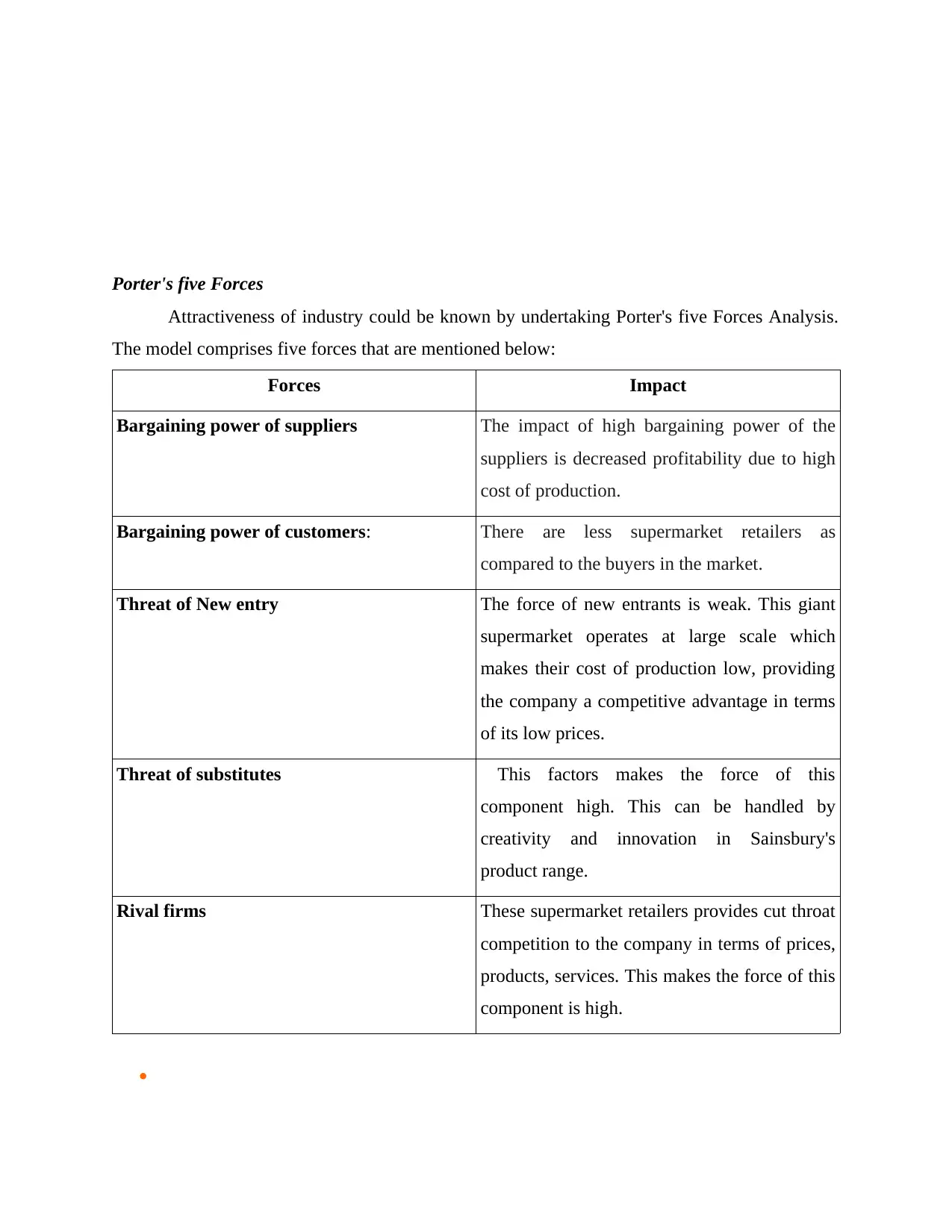
Porter's five Forces
Attractiveness of industry could be known by undertaking Porter's five Forces Analysis.
The model comprises five forces that are mentioned below:
Forces Impact
Bargaining power of suppliers The impact of high bargaining power of the
suppliers is decreased profitability due to high
cost of production.
Bargaining power of customers: There are less supermarket retailers as
compared to the buyers in the market.
Threat of New entry The force of new entrants is weak. This giant
supermarket operates at large scale which
makes their cost of production low, providing
the company a competitive advantage in terms
of its low prices.
Threat of substitutes This factors makes the force of this
component high. This can be handled by
creativity and innovation in Sainsbury's
product range.
Rival firms These supermarket retailers provides cut throat
competition to the company in terms of prices,
products, services. This makes the force of this
component is high.
Attractiveness of industry could be known by undertaking Porter's five Forces Analysis.
The model comprises five forces that are mentioned below:
Forces Impact
Bargaining power of suppliers The impact of high bargaining power of the
suppliers is decreased profitability due to high
cost of production.
Bargaining power of customers: There are less supermarket retailers as
compared to the buyers in the market.
Threat of New entry The force of new entrants is weak. This giant
supermarket operates at large scale which
makes their cost of production low, providing
the company a competitive advantage in terms
of its low prices.
Threat of substitutes This factors makes the force of this
component high. This can be handled by
creativity and innovation in Sainsbury's
product range.
Rival firms These supermarket retailers provides cut throat
competition to the company in terms of prices,
products, services. This makes the force of this
component is high.
⊘ This is a preview!⊘
Do you want full access?
Subscribe today to unlock all pages.

Trusted by 1+ million students worldwide
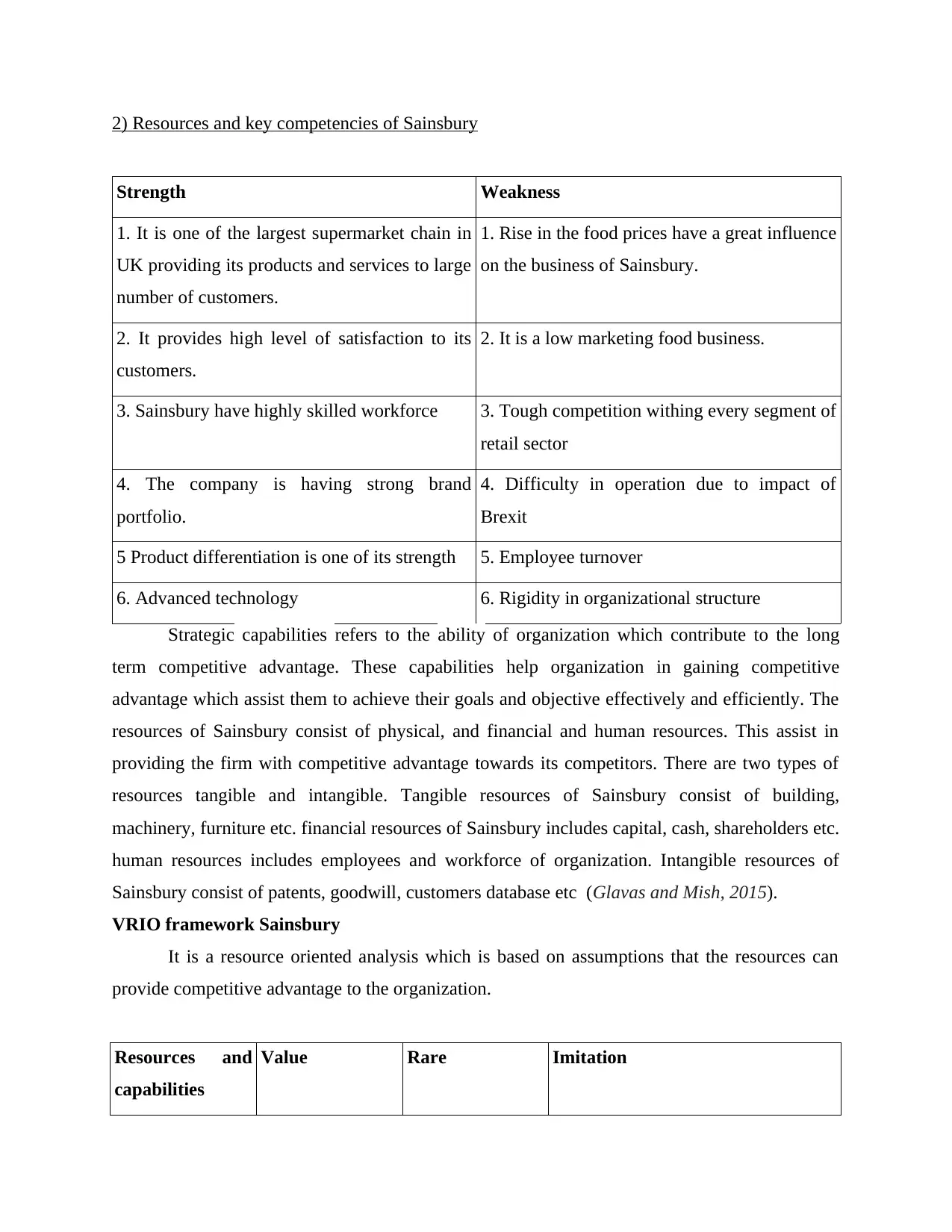
2) Resources and key competencies of Sainsbury
Strength Weakness
1. It is one of the largest supermarket chain in
UK providing its products and services to large
number of customers.
1. Rise in the food prices have a great influence
on the business of Sainsbury.
2. It provides high level of satisfaction to its
customers.
2. It is a low marketing food business.
3. Sainsbury have highly skilled workforce 3. Tough competition withing every segment of
retail sector
4. The company is having strong brand
portfolio.
4. Difficulty in operation due to impact of
Brexit
5 Product differentiation is one of its strength 5. Employee turnover
6. Advanced technology 6. Rigidity in organizational structure
Strategic capabilities refers to the ability of organization which contribute to the long
term competitive advantage. These capabilities help organization in gaining competitive
advantage which assist them to achieve their goals and objective effectively and efficiently. The
resources of Sainsbury consist of physical, and financial and human resources. This assist in
providing the firm with competitive advantage towards its competitors. There are two types of
resources tangible and intangible. Tangible resources of Sainsbury consist of building,
machinery, furniture etc. financial resources of Sainsbury includes capital, cash, shareholders etc.
human resources includes employees and workforce of organization. Intangible resources of
Sainsbury consist of patents, goodwill, customers database etc (Glavas and Mish, 2015).
VRIO framework Sainsbury
It is a resource oriented analysis which is based on assumptions that the resources can
provide competitive advantage to the organization.
Resources and
capabilities
Value Rare Imitation
Strength Weakness
1. It is one of the largest supermarket chain in
UK providing its products and services to large
number of customers.
1. Rise in the food prices have a great influence
on the business of Sainsbury.
2. It provides high level of satisfaction to its
customers.
2. It is a low marketing food business.
3. Sainsbury have highly skilled workforce 3. Tough competition withing every segment of
retail sector
4. The company is having strong brand
portfolio.
4. Difficulty in operation due to impact of
Brexit
5 Product differentiation is one of its strength 5. Employee turnover
6. Advanced technology 6. Rigidity in organizational structure
Strategic capabilities refers to the ability of organization which contribute to the long
term competitive advantage. These capabilities help organization in gaining competitive
advantage which assist them to achieve their goals and objective effectively and efficiently. The
resources of Sainsbury consist of physical, and financial and human resources. This assist in
providing the firm with competitive advantage towards its competitors. There are two types of
resources tangible and intangible. Tangible resources of Sainsbury consist of building,
machinery, furniture etc. financial resources of Sainsbury includes capital, cash, shareholders etc.
human resources includes employees and workforce of organization. Intangible resources of
Sainsbury consist of patents, goodwill, customers database etc (Glavas and Mish, 2015).
VRIO framework Sainsbury
It is a resource oriented analysis which is based on assumptions that the resources can
provide competitive advantage to the organization.
Resources and
capabilities
Value Rare Imitation
Paraphrase This Document
Need a fresh take? Get an instant paraphrase of this document with our AI Paraphraser
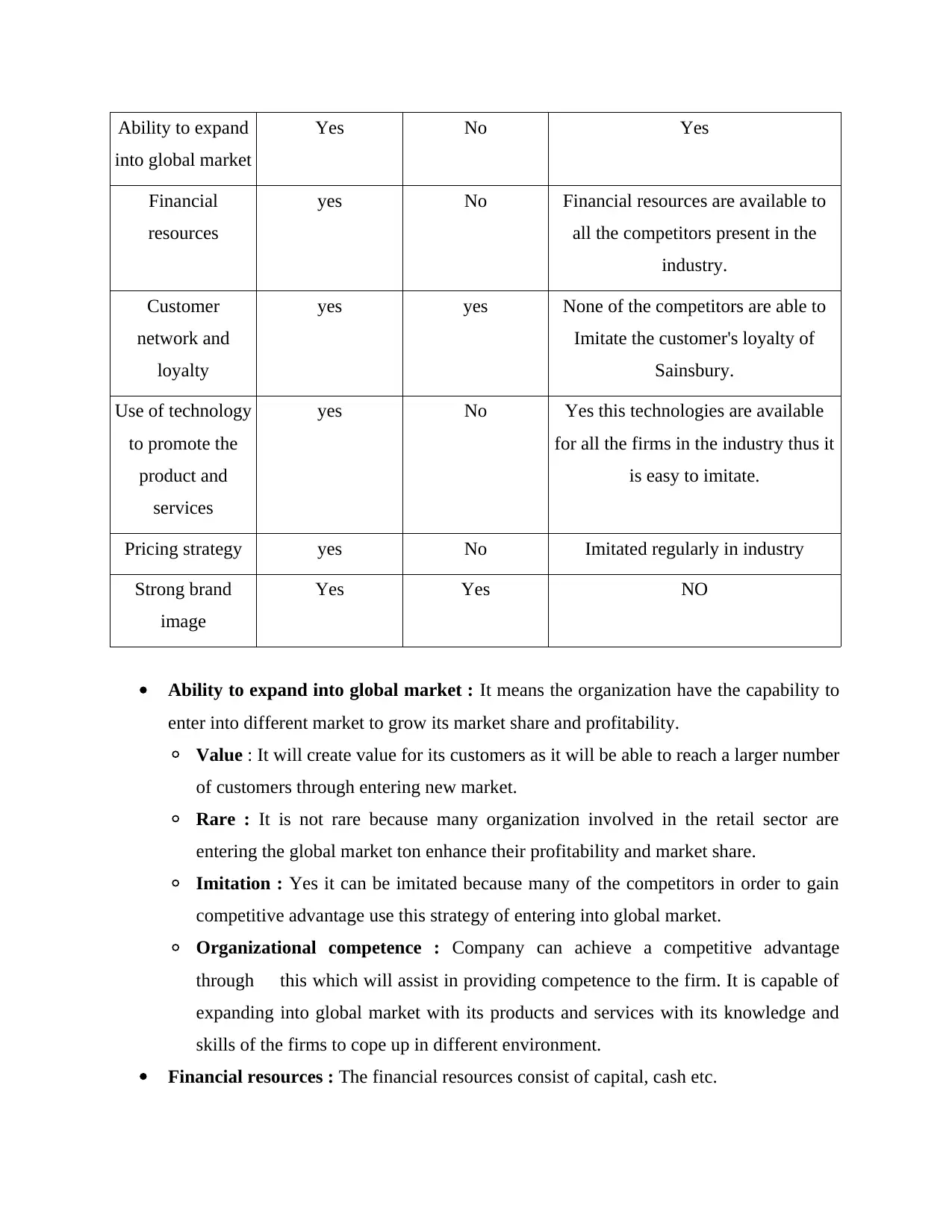
Ability to expand
into global market
Yes No Yes
Financial
resources
yes No Financial resources are available to
all the competitors present in the
industry.
Customer
network and
loyalty
yes yes None of the competitors are able to
Imitate the customer's loyalty of
Sainsbury.
Use of technology
to promote the
product and
services
yes No Yes this technologies are available
for all the firms in the industry thus it
is easy to imitate.
Pricing strategy yes No Imitated regularly in industry
Strong brand
image
Yes Yes NO
Ability to expand into global market : It means the organization have the capability to
enter into different market to grow its market share and profitability.
◦ Value : It will create value for its customers as it will be able to reach a larger number
of customers through entering new market.
◦ Rare : It is not rare because many organization involved in the retail sector are
entering the global market ton enhance their profitability and market share.
◦ Imitation : Yes it can be imitated because many of the competitors in order to gain
competitive advantage use this strategy of entering into global market.
◦ Organizational competence : Company can achieve a competitive advantage
through this which will assist in providing competence to the firm. It is capable of
expanding into global market with its products and services with its knowledge and
skills of the firms to cope up in different environment.
Financial resources : The financial resources consist of capital, cash etc.
into global market
Yes No Yes
Financial
resources
yes No Financial resources are available to
all the competitors present in the
industry.
Customer
network and
loyalty
yes yes None of the competitors are able to
Imitate the customer's loyalty of
Sainsbury.
Use of technology
to promote the
product and
services
yes No Yes this technologies are available
for all the firms in the industry thus it
is easy to imitate.
Pricing strategy yes No Imitated regularly in industry
Strong brand
image
Yes Yes NO
Ability to expand into global market : It means the organization have the capability to
enter into different market to grow its market share and profitability.
◦ Value : It will create value for its customers as it will be able to reach a larger number
of customers through entering new market.
◦ Rare : It is not rare because many organization involved in the retail sector are
entering the global market ton enhance their profitability and market share.
◦ Imitation : Yes it can be imitated because many of the competitors in order to gain
competitive advantage use this strategy of entering into global market.
◦ Organizational competence : Company can achieve a competitive advantage
through this which will assist in providing competence to the firm. It is capable of
expanding into global market with its products and services with its knowledge and
skills of the firms to cope up in different environment.
Financial resources : The financial resources consist of capital, cash etc.
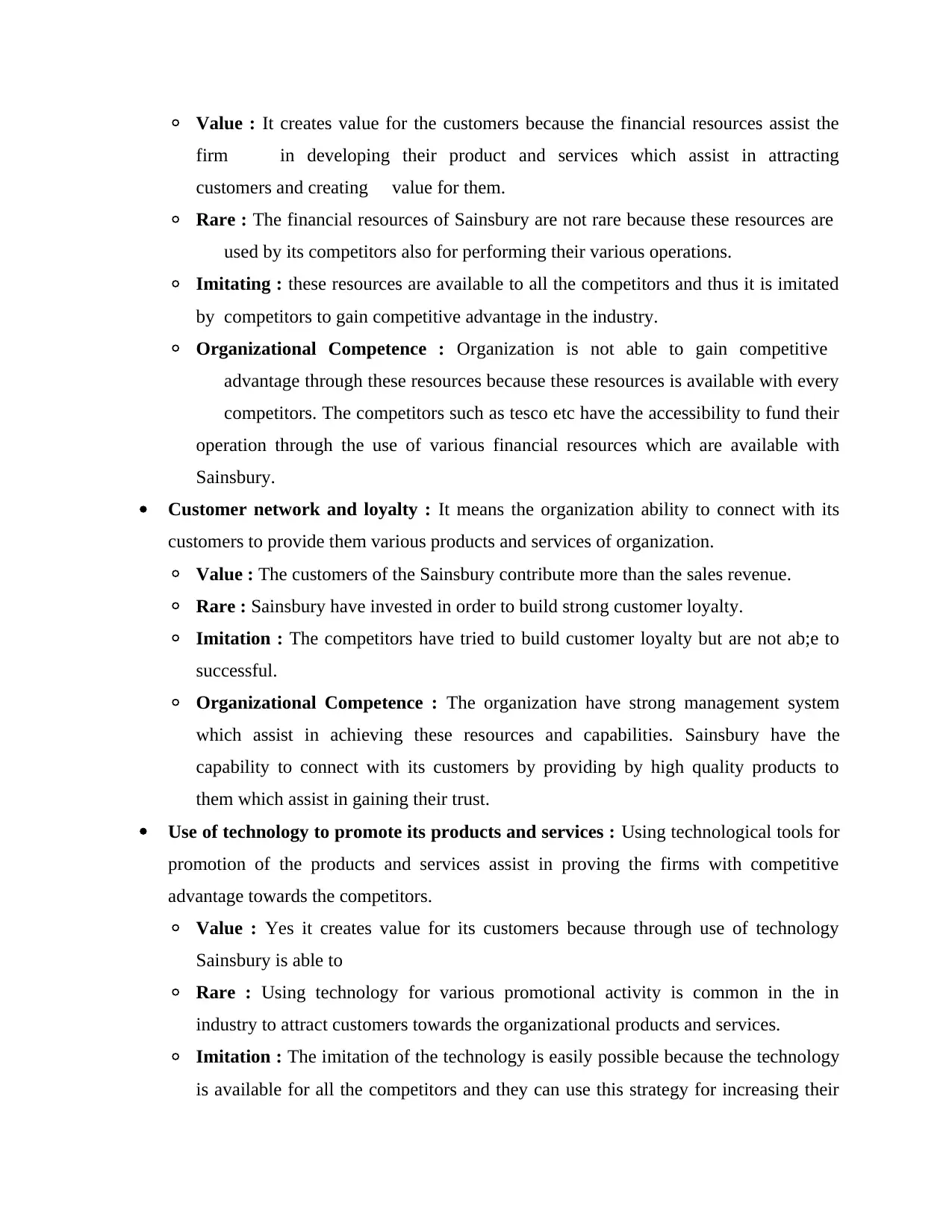
◦ Value : It creates value for the customers because the financial resources assist the
firm in developing their product and services which assist in attracting
customers and creating value for them.
◦ Rare : The financial resources of Sainsbury are not rare because these resources are
used by its competitors also for performing their various operations.
◦ Imitating : these resources are available to all the competitors and thus it is imitated
by competitors to gain competitive advantage in the industry.
◦ Organizational Competence : Organization is not able to gain competitive
advantage through these resources because these resources is available with every
competitors. The competitors such as tesco etc have the accessibility to fund their
operation through the use of various financial resources which are available with
Sainsbury.
Customer network and loyalty : It means the organization ability to connect with its
customers to provide them various products and services of organization.
◦ Value : The customers of the Sainsbury contribute more than the sales revenue.
◦ Rare : Sainsbury have invested in order to build strong customer loyalty.
◦ Imitation : The competitors have tried to build customer loyalty but are not ab;e to
successful.
◦ Organizational Competence : The organization have strong management system
which assist in achieving these resources and capabilities. Sainsbury have the
capability to connect with its customers by providing by high quality products to
them which assist in gaining their trust.
Use of technology to promote its products and services : Using technological tools for
promotion of the products and services assist in proving the firms with competitive
advantage towards the competitors.
◦ Value : Yes it creates value for its customers because through use of technology
Sainsbury is able to
◦ Rare : Using technology for various promotional activity is common in the in
industry to attract customers towards the organizational products and services.
◦ Imitation : The imitation of the technology is easily possible because the technology
is available for all the competitors and they can use this strategy for increasing their
firm in developing their product and services which assist in attracting
customers and creating value for them.
◦ Rare : The financial resources of Sainsbury are not rare because these resources are
used by its competitors also for performing their various operations.
◦ Imitating : these resources are available to all the competitors and thus it is imitated
by competitors to gain competitive advantage in the industry.
◦ Organizational Competence : Organization is not able to gain competitive
advantage through these resources because these resources is available with every
competitors. The competitors such as tesco etc have the accessibility to fund their
operation through the use of various financial resources which are available with
Sainsbury.
Customer network and loyalty : It means the organization ability to connect with its
customers to provide them various products and services of organization.
◦ Value : The customers of the Sainsbury contribute more than the sales revenue.
◦ Rare : Sainsbury have invested in order to build strong customer loyalty.
◦ Imitation : The competitors have tried to build customer loyalty but are not ab;e to
successful.
◦ Organizational Competence : The organization have strong management system
which assist in achieving these resources and capabilities. Sainsbury have the
capability to connect with its customers by providing by high quality products to
them which assist in gaining their trust.
Use of technology to promote its products and services : Using technological tools for
promotion of the products and services assist in proving the firms with competitive
advantage towards the competitors.
◦ Value : Yes it creates value for its customers because through use of technology
Sainsbury is able to
◦ Rare : Using technology for various promotional activity is common in the in
industry to attract customers towards the organizational products and services.
◦ Imitation : The imitation of the technology is easily possible because the technology
is available for all the competitors and they can use this strategy for increasing their
⊘ This is a preview!⊘
Do you want full access?
Subscribe today to unlock all pages.

Trusted by 1+ million students worldwide
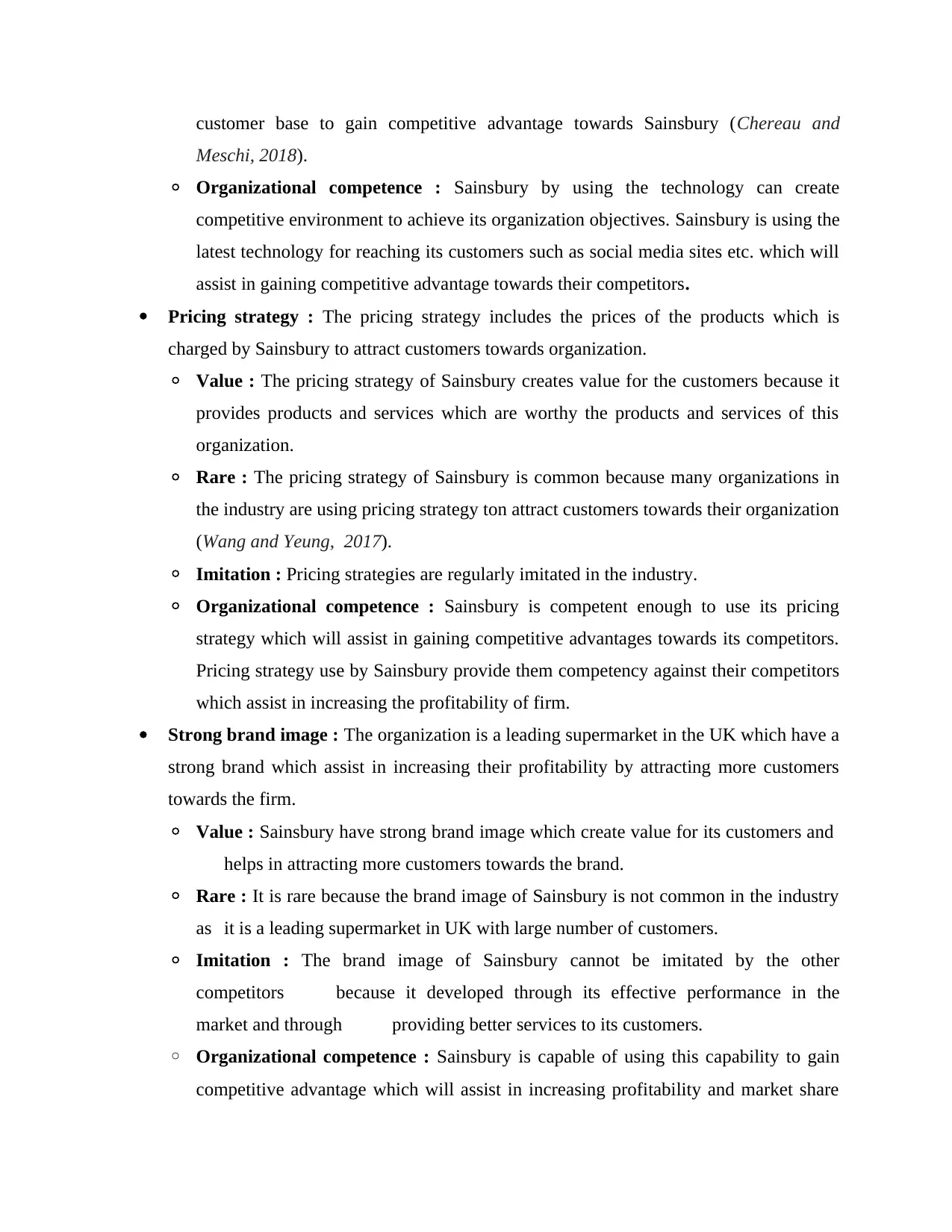
customer base to gain competitive advantage towards Sainsbury (Chereau and
Meschi, 2018).
◦ Organizational competence : Sainsbury by using the technology can create
competitive environment to achieve its organization objectives. Sainsbury is using the
latest technology for reaching its customers such as social media sites etc. which will
assist in gaining competitive advantage towards their competitors.
Pricing strategy : The pricing strategy includes the prices of the products which is
charged by Sainsbury to attract customers towards organization.
◦ Value : The pricing strategy of Sainsbury creates value for the customers because it
provides products and services which are worthy the products and services of this
organization.
◦ Rare : The pricing strategy of Sainsbury is common because many organizations in
the industry are using pricing strategy ton attract customers towards their organization
(Wang and Yeung, 2017).
◦ Imitation : Pricing strategies are regularly imitated in the industry.
◦ Organizational competence : Sainsbury is competent enough to use its pricing
strategy which will assist in gaining competitive advantages towards its competitors.
Pricing strategy use by Sainsbury provide them competency against their competitors
which assist in increasing the profitability of firm.
Strong brand image : The organization is a leading supermarket in the UK which have a
strong brand which assist in increasing their profitability by attracting more customers
towards the firm.
◦ Value : Sainsbury have strong brand image which create value for its customers and
helps in attracting more customers towards the brand.
◦ Rare : It is rare because the brand image of Sainsbury is not common in the industry
as it is a leading supermarket in UK with large number of customers.
◦ Imitation : The brand image of Sainsbury cannot be imitated by the other
competitors because it developed through its effective performance in the
market and through providing better services to its customers.
◦ Organizational competence : Sainsbury is capable of using this capability to gain
competitive advantage which will assist in increasing profitability and market share
Meschi, 2018).
◦ Organizational competence : Sainsbury by using the technology can create
competitive environment to achieve its organization objectives. Sainsbury is using the
latest technology for reaching its customers such as social media sites etc. which will
assist in gaining competitive advantage towards their competitors.
Pricing strategy : The pricing strategy includes the prices of the products which is
charged by Sainsbury to attract customers towards organization.
◦ Value : The pricing strategy of Sainsbury creates value for the customers because it
provides products and services which are worthy the products and services of this
organization.
◦ Rare : The pricing strategy of Sainsbury is common because many organizations in
the industry are using pricing strategy ton attract customers towards their organization
(Wang and Yeung, 2017).
◦ Imitation : Pricing strategies are regularly imitated in the industry.
◦ Organizational competence : Sainsbury is competent enough to use its pricing
strategy which will assist in gaining competitive advantages towards its competitors.
Pricing strategy use by Sainsbury provide them competency against their competitors
which assist in increasing the profitability of firm.
Strong brand image : The organization is a leading supermarket in the UK which have a
strong brand which assist in increasing their profitability by attracting more customers
towards the firm.
◦ Value : Sainsbury have strong brand image which create value for its customers and
helps in attracting more customers towards the brand.
◦ Rare : It is rare because the brand image of Sainsbury is not common in the industry
as it is a leading supermarket in UK with large number of customers.
◦ Imitation : The brand image of Sainsbury cannot be imitated by the other
competitors because it developed through its effective performance in the
market and through providing better services to its customers.
◦ Organizational competence : Sainsbury is capable of using this capability to gain
competitive advantage which will assist in increasing profitability and market share
Paraphrase This Document
Need a fresh take? Get an instant paraphrase of this document with our AI Paraphraser
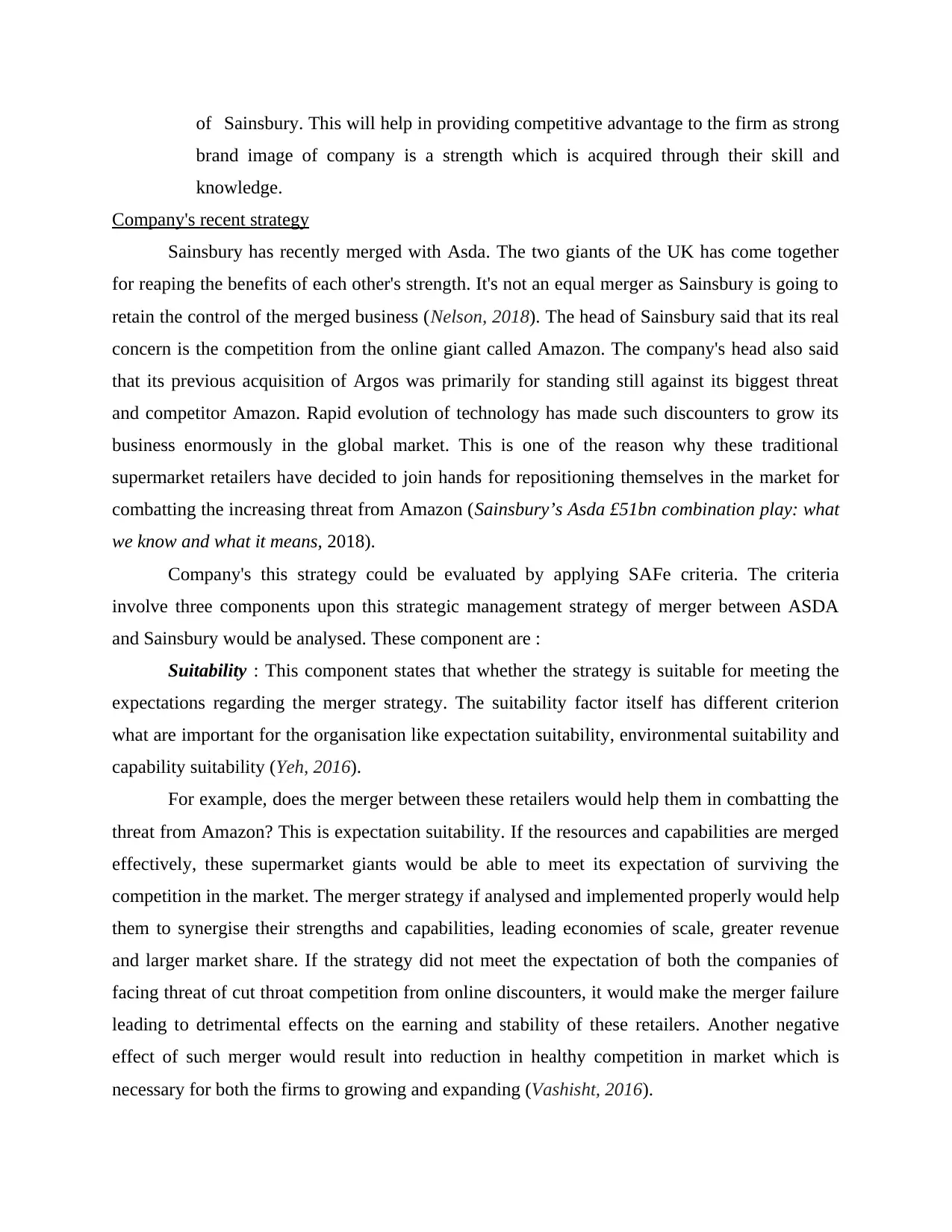
of Sainsbury. This will help in providing competitive advantage to the firm as strong
brand image of company is a strength which is acquired through their skill and
knowledge.
Company's recent strategy
Sainsbury has recently merged with Asda. The two giants of the UK has come together
for reaping the benefits of each other's strength. It's not an equal merger as Sainsbury is going to
retain the control of the merged business (Nelson, 2018). The head of Sainsbury said that its real
concern is the competition from the online giant called Amazon. The company's head also said
that its previous acquisition of Argos was primarily for standing still against its biggest threat
and competitor Amazon. Rapid evolution of technology has made such discounters to grow its
business enormously in the global market. This is one of the reason why these traditional
supermarket retailers have decided to join hands for repositioning themselves in the market for
combatting the increasing threat from Amazon (Sainsbury’s Asda £51bn combination play: what
we know and what it means, 2018).
Company's this strategy could be evaluated by applying SAFe criteria. The criteria
involve three components upon this strategic management strategy of merger between ASDA
and Sainsbury would be analysed. These component are :
Suitability : This component states that whether the strategy is suitable for meeting the
expectations regarding the merger strategy. The suitability factor itself has different criterion
what are important for the organisation like expectation suitability, environmental suitability and
capability suitability (Yeh, 2016).
For example, does the merger between these retailers would help them in combatting the
threat from Amazon? This is expectation suitability. If the resources and capabilities are merged
effectively, these supermarket giants would be able to meet its expectation of surviving the
competition in the market. The merger strategy if analysed and implemented properly would help
them to synergise their strengths and capabilities, leading economies of scale, greater revenue
and larger market share. If the strategy did not meet the expectation of both the companies of
facing threat of cut throat competition from online discounters, it would make the merger failure
leading to detrimental effects on the earning and stability of these retailers. Another negative
effect of such merger would result into reduction in healthy competition in market which is
necessary for both the firms to growing and expanding (Vashisht, 2016).
brand image of company is a strength which is acquired through their skill and
knowledge.
Company's recent strategy
Sainsbury has recently merged with Asda. The two giants of the UK has come together
for reaping the benefits of each other's strength. It's not an equal merger as Sainsbury is going to
retain the control of the merged business (Nelson, 2018). The head of Sainsbury said that its real
concern is the competition from the online giant called Amazon. The company's head also said
that its previous acquisition of Argos was primarily for standing still against its biggest threat
and competitor Amazon. Rapid evolution of technology has made such discounters to grow its
business enormously in the global market. This is one of the reason why these traditional
supermarket retailers have decided to join hands for repositioning themselves in the market for
combatting the increasing threat from Amazon (Sainsbury’s Asda £51bn combination play: what
we know and what it means, 2018).
Company's this strategy could be evaluated by applying SAFe criteria. The criteria
involve three components upon this strategic management strategy of merger between ASDA
and Sainsbury would be analysed. These component are :
Suitability : This component states that whether the strategy is suitable for meeting the
expectations regarding the merger strategy. The suitability factor itself has different criterion
what are important for the organisation like expectation suitability, environmental suitability and
capability suitability (Yeh, 2016).
For example, does the merger between these retailers would help them in combatting the
threat from Amazon? This is expectation suitability. If the resources and capabilities are merged
effectively, these supermarket giants would be able to meet its expectation of surviving the
competition in the market. The merger strategy if analysed and implemented properly would help
them to synergise their strengths and capabilities, leading economies of scale, greater revenue
and larger market share. If the strategy did not meet the expectation of both the companies of
facing threat of cut throat competition from online discounters, it would make the merger failure
leading to detrimental effects on the earning and stability of these retailers. Another negative
effect of such merger would result into reduction in healthy competition in market which is
necessary for both the firms to growing and expanding (Vashisht, 2016).
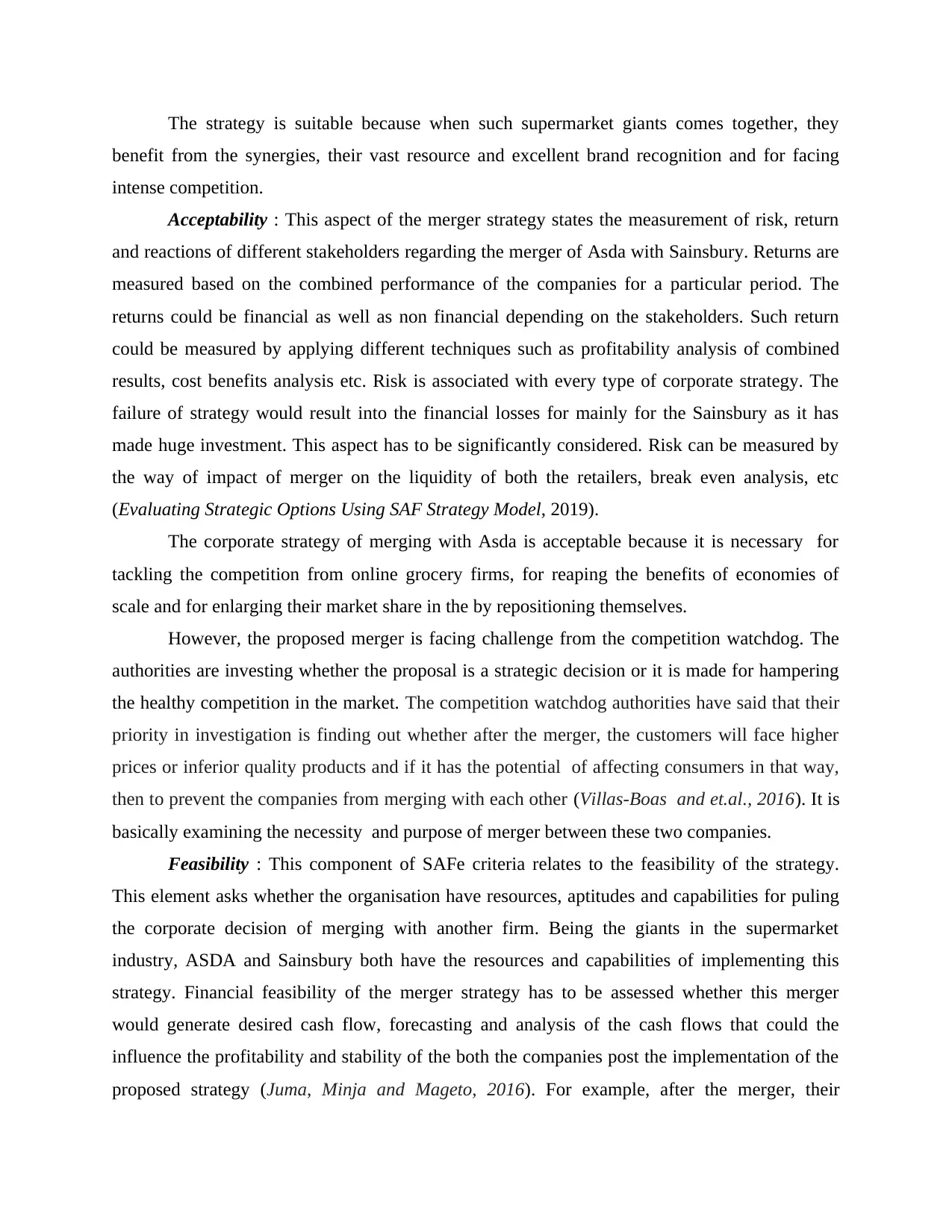
The strategy is suitable because when such supermarket giants comes together, they
benefit from the synergies, their vast resource and excellent brand recognition and for facing
intense competition.
Acceptability : This aspect of the merger strategy states the measurement of risk, return
and reactions of different stakeholders regarding the merger of Asda with Sainsbury. Returns are
measured based on the combined performance of the companies for a particular period. The
returns could be financial as well as non financial depending on the stakeholders. Such return
could be measured by applying different techniques such as profitability analysis of combined
results, cost benefits analysis etc. Risk is associated with every type of corporate strategy. The
failure of strategy would result into the financial losses for mainly for the Sainsbury as it has
made huge investment. This aspect has to be significantly considered. Risk can be measured by
the way of impact of merger on the liquidity of both the retailers, break even analysis, etc
(Evaluating Strategic Options Using SAF Strategy Model, 2019).
The corporate strategy of merging with Asda is acceptable because it is necessary for
tackling the competition from online grocery firms, for reaping the benefits of economies of
scale and for enlarging their market share in the by repositioning themselves.
However, the proposed merger is facing challenge from the competition watchdog. The
authorities are investing whether the proposal is a strategic decision or it is made for hampering
the healthy competition in the market. The competition watchdog authorities have said that their
priority in investigation is finding out whether after the merger, the customers will face higher
prices or inferior quality products and if it has the potential of affecting consumers in that way,
then to prevent the companies from merging with each other (Villas-Boas and et.al., 2016). It is
basically examining the necessity and purpose of merger between these two companies.
Feasibility : This component of SAFe criteria relates to the feasibility of the strategy.
This element asks whether the organisation have resources, aptitudes and capabilities for puling
the corporate decision of merging with another firm. Being the giants in the supermarket
industry, ASDA and Sainsbury both have the resources and capabilities of implementing this
strategy. Financial feasibility of the merger strategy has to be assessed whether this merger
would generate desired cash flow, forecasting and analysis of the cash flows that could the
influence the profitability and stability of the both the companies post the implementation of the
proposed strategy (Juma, Minja and Mageto, 2016). For example, after the merger, their
benefit from the synergies, their vast resource and excellent brand recognition and for facing
intense competition.
Acceptability : This aspect of the merger strategy states the measurement of risk, return
and reactions of different stakeholders regarding the merger of Asda with Sainsbury. Returns are
measured based on the combined performance of the companies for a particular period. The
returns could be financial as well as non financial depending on the stakeholders. Such return
could be measured by applying different techniques such as profitability analysis of combined
results, cost benefits analysis etc. Risk is associated with every type of corporate strategy. The
failure of strategy would result into the financial losses for mainly for the Sainsbury as it has
made huge investment. This aspect has to be significantly considered. Risk can be measured by
the way of impact of merger on the liquidity of both the retailers, break even analysis, etc
(Evaluating Strategic Options Using SAF Strategy Model, 2019).
The corporate strategy of merging with Asda is acceptable because it is necessary for
tackling the competition from online grocery firms, for reaping the benefits of economies of
scale and for enlarging their market share in the by repositioning themselves.
However, the proposed merger is facing challenge from the competition watchdog. The
authorities are investing whether the proposal is a strategic decision or it is made for hampering
the healthy competition in the market. The competition watchdog authorities have said that their
priority in investigation is finding out whether after the merger, the customers will face higher
prices or inferior quality products and if it has the potential of affecting consumers in that way,
then to prevent the companies from merging with each other (Villas-Boas and et.al., 2016). It is
basically examining the necessity and purpose of merger between these two companies.
Feasibility : This component of SAFe criteria relates to the feasibility of the strategy.
This element asks whether the organisation have resources, aptitudes and capabilities for puling
the corporate decision of merging with another firm. Being the giants in the supermarket
industry, ASDA and Sainsbury both have the resources and capabilities of implementing this
strategy. Financial feasibility of the merger strategy has to be assessed whether this merger
would generate desired cash flow, forecasting and analysis of the cash flows that could the
influence the profitability and stability of the both the companies post the implementation of the
proposed strategy (Juma, Minja and Mageto, 2016). For example, after the merger, their
⊘ This is a preview!⊘
Do you want full access?
Subscribe today to unlock all pages.

Trusted by 1+ million students worldwide
1 out of 20
Related Documents
Your All-in-One AI-Powered Toolkit for Academic Success.
+13062052269
info@desklib.com
Available 24*7 on WhatsApp / Email
![[object Object]](/_next/static/media/star-bottom.7253800d.svg)
Unlock your academic potential
Copyright © 2020–2025 A2Z Services. All Rights Reserved. Developed and managed by ZUCOL.




